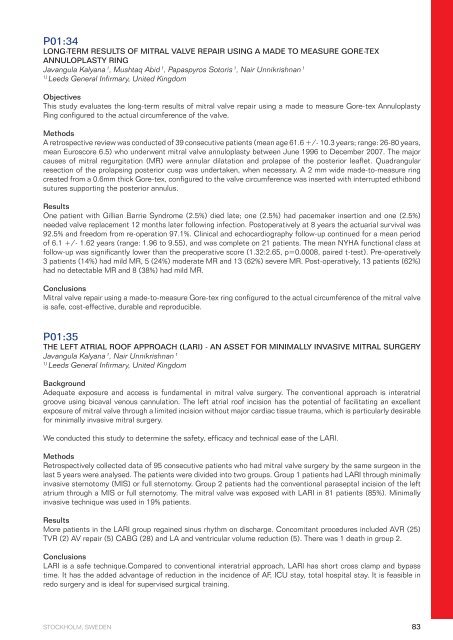SATS 2009 Final Program - Scandinavian Association for Thoracic ...
SATS 2009 Final Program - Scandinavian Association for Thoracic ...
SATS 2009 Final Program - Scandinavian Association for Thoracic ...
Create successful ePaper yourself
Turn your PDF publications into a flip-book with our unique Google optimized e-Paper software.
P01:34<br />
LONG-TERM RESULTS OF MITRAL VALVE REPAIR USING A MADE TO MEASURE GORE-TEX<br />
ANNULOPLASTY RING<br />
Javangula Kalyana 1 , Mushtaq Abid 1 , Papaspyros Sotoris 1 , Nair Unnikrishnan 1<br />
1) Leeds General Infirmary, United Kingdom<br />
Objectives<br />
This study evaluates the long-term results of mitral valve repair using a made to measure Gore-tex Annuloplasty<br />
Ring configured to the actual circumference of the valve.<br />
Methods<br />
A retrospective review was conducted of 39 consecutive patients (mean age 61.6 +/- 10.3 years; range: 26-80 years,<br />
mean Euroscore 6.5) who underwent mitral valve annuloplasty between June 1996 to December 2007. The major<br />
causes of mitral regurgitation (MR) were annular dilatation and prolapse of the posterior leaflet. Quadrangular<br />
resection of the prolapsing posterior cusp was undertaken, when necessary. A 2 mm wide made-to-measure ring<br />
created from a 0.6mm thick Gore-tex, configured to the valve circumference was inserted with interrupted ethibond<br />
sutures supporting the posterior annulus.<br />
Results<br />
One patient with Gillian Barrie Syndrome (2.5%) died late; one (2.5%) had pacemaker insertion and one (2.5%)<br />
needed valve replacement 12 months later following infection. Postoperatively at 8 years the actuarial survival was<br />
92.5% and freedom from re-operation 97.1%. Clinical and echocardiography follow-up continued <strong>for</strong> a mean period<br />
of 6.1 +/- 1.62 years (range: 1.96 to 9.55), and was complete on 21 patients. The mean NYHA functional class at<br />
follow-up was significantly lower than the preoperative score (1.32:2.65, p=0.0008, paired t-test). Pre-operatively<br />
3 patients (14%) had mild MR, 5 (24%) moderate MR and 13 (62%) severe MR. Post-operatively, 13 patients (62%)<br />
had no detectable MR and 8 (38%) had mild MR.<br />
Conclusions<br />
Mitral valve repair using a made-to-measure Gore-tex ring configured to the actual circumference of the mitral valve<br />
is safe, cost-effective, durable and reproducible.<br />
P01:35<br />
THE LEFT ATRIAL ROOF APPROACH (LARI) - AN ASSET FOR MINIMALLY INVASIVE MITRAL SURGERY<br />
Javangula Kalyana 1 , Nair Unnikrishnan 1<br />
1) Leeds General Infirmary, United Kingdom<br />
Background<br />
Adequate exposure and access is fundamental in mitral valve surgery. The conventional approach is interatrial<br />
groove using bicaval venous cannulation. The left atrial roof incision has the potential of facilitating an excellent<br />
exposure of mitral valve through a limited incision without major cardiac tissue trauma, which is particularly desirable<br />
<strong>for</strong> minimally invasive mitral surgery.<br />
We conducted this study to determine the safety, efficacy and technical ease of the LARI.<br />
Methods<br />
Retrospectively collected data of 95 consecutive patients who had mitral valve surgery by the same surgeon in the<br />
last 5 years were analysed. The patients were divided into two groups. Group 1 patients had LARI through minimally<br />
invasive sternotomy (MIS) or full sternotomy. Group 2 patients had the conventional paraseptal incision of the left<br />
atrium through a MIS or full sternotomy. The mitral valve was exposed with LARI in 81 patients (85%). Minimally<br />
invasive technique was used in 19% patients.<br />
Results<br />
More patients in the LARI group regained sinus rhythm on discharge. Concomitant procedures included AVR (25)<br />
TVR (2) AV repair (5) CABG (28) and LA and ventricular volume reduction (5). There was 1 death in group 2.<br />
Conclusions<br />
LARI is a safe technique.Compared to conventional interatrial approach, LARI has short cross clamp and bypass<br />
time. It has the added advantage of reduction in the incidence of AF, ICU stay, total hospital stay. It is feasible in<br />
redo surgery and is ideal <strong>for</strong> supervised surgical training.<br />
STOCKHOLM, SWEDEN 83


